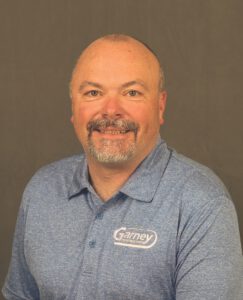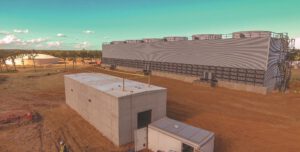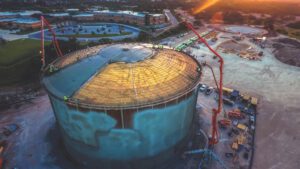Vista Ridge, a major project that will supply the city of San Antonio, Texas, with water for the next 30 years, is the largest municipal public-private partnership (P3) project in the United States. Garney Construction, a company with long-standing expertise in laying water pipeline, is currently the majority owner and developer of the project and has taken out loans totaling nearly a billion dollars to build it.
In this interview with Municipal Water Leader Editor-in-Chief Kris Polly, Scott Parrish, the president of Garney Construction, tells us about the company, the status of the Vista Ridge project, and the advantages and unique challenges of the P3 funding model.
 Kris Polly: Please tell us a bit about your personal background.
Kris Polly: Please tell us a bit about your personal background.
Scott Parrish: I’m from Pawnee City, a small town in Nebraska. My real and ongoing education came from Garney Construction. I started in the field as a laborer in 1988. August 20 marked the start of my 31st year as an employee-owner.
Kris Polly: Tell us about Garney, its history, and what the company is all about.
Scott Parrish: We were founded by Charles Garney in 1961. Charles started our employee stock ownership plan in 1986. We became 100 percent employee owned in 1995 when the employees bought the remaining shares from Charles. Everyone from the new hire on the blister end of a shovel to the chief executive officer is an owner and shares in the benefits and obligations that company owners experience. We’ve had slow and steady growth over the company’s history: There are currently approximately 1,400 employee-owners working from coast to coast.
Kris Polly: Where was Mr. Garney from?
Scott Parrish: Charles Garney was from Kansas City, Missouri. He worked for his dad at Garney Plumbing; Garney Construction was spun off from that company. The plumbers installed everything from the mains to the houses, and Charles started our company to install the water and sewer mains themselves.
Kris Polly: What is Garney’s geographical range of operations?
Scott Parrish: The core of our business is in the United States, from coast to coast.
Kris Polly: Let’s say you have a project. Do you move people? Do you hire people? How does a typical project work?
Scott Parrish: All of the above. We have 17 regional offices covering the United States, and we try to keep our workers within a region, but we have to go where the work is. If we don’t have resources where the project is, we move a core group of experienced employee-owners to the area and then hire locally to meet the staffing requirements.
Kris Polly: Would you say that laying pipelines is your core business?
Scott Parrish: We have two core businesses: pipe work and plant work. Our tag line is Advancing Water, and we build anything that has to do with water.
Kris Polly: Tell us about Vista Ridge.
Scott Parrish: Vista Ridge is the largest municipal P3 project in the United States. The total value of the loan that we took out from a consortium of 11 banks for this project was $927 million. Vista Ridge is based around a Water Transportation and Purchase Agreement (WTPA) to provide the city of San Antonio with 50,000 acre-feet of water per year for 30 years. The infrastructure for the project includes 142 miles of transmission line—roughly 25 percent is 54 inch and the other 75 percent is 60 inch. There is a well field containing 18 deep wells that are drilled roughly 1/2mile into the aquifer. There are three pump stations: a high-service pump station near the well field that pumps the water roughly a third of the way down the transmission line as well as two intermediate pump stations. Finally, there is a delivery point, which is called the terminus site.
 Kris Polly: Is this the biggest project that Garney has ever done?
Kris Polly: Is this the biggest project that Garney has ever done?
Scott Parrish: It sure is.
Kris Polly: What is the status of the project? When will it be completed?
Scott Parrish: We’re about 65 percent done with the project right now. The commercial operation date is set for April 15, 2020. By contract, we can’t deliver any water for project startup prior to January 17, 2020.
Kris Polly: Can you give us a sense of how many people you have working on this project and what kind of equipment they are using?
Scott Parrish: We’ve got 11 crews comprising approximately 200 employee-owners. A crew usually ranges from 5 to 15 people. We have six pipe crews, four support crews, and one plant crew currently allocated to this project.
Kris Polly: What are the primary materials of your pipelines?
Scott Parrish: There are two primary materials. One is C200 polyurethane-coated, mortar-lined steel. The other is C303 concrete cylinder pipe. Both are made by Thompson Pipe Group.
Kris Polly: Tell us about the P3 arrangement. Who is involved?
Scott Parrish: The project’s foundation is the WTPA. The WTPA is a contract to provide San Antonio Water Systems 50,000 acre-feet of water per year for 30 years in a take-or-pay arrangement. Vista Ridge LLC holds this contract. Central Texas Regional Water Supply Corporation hired Garney to design-build the infrastructure (including the well field, the high-service pump station, the transmission line, the two intermediate pump stations, and the terminus) that will draw water from the aquifer and deliver it to San Antonio Water Systems. Central Texas Regional Water Supply Corporation and Vista Ridge LLC were coborrowers on the $927 million loan used to develop and construct the Vista Ridge project. Central Texas Regional Water Supply Corporation and Vista Ridge LLC have contracted with the utility company EPCOR to operate the water system. The debt service, return on equity, and cost of operations will be paid by the water payments made by San Antonio Water Systems to Vista Ridge LLC over the 30-year contract duration. It’s important to note that Garney relied heavily on our engineering partners Pape Dawson and CP&Y. Gene Dawson’s involvement throughout the project has been a cornerstone of the project’s success.
Kris Polly: Are you the owner of the project?
Scott Parrish: When we assumed control of the project prior to financial close, we were the majority shareholder in Vista Ridge LLC, the company that holds the WTPA contract, with an 80 percent ownership interest. Twenty percent was owned by a passive partner, Abengoa. During the early phase of construction, we sold a 29 percent interest to Ridgewood, an asset-management firm. Ridgewood has since sold a 5 percent interest to EPCOR. As it stands, the current ownership stakes in Vista Ridge LLC are Garney with 51 percent, Ridgewood with 24 percent, Abengoa with 20 percent, and EPCOR with 5 percent.

Kris Polly: So Garney made the decision to invest in this project and to build it, and you’ll retain ownership for the next 30 years.
Scott Parrish: Actually, no. We have a contract to sell our remaining interests in Vista Ridge LLC to Ridgewood when we achieve commercial operation. Garney’s expertise is building projects. Our primary book of business is construction. Although we considered holding a long-term interest in Vista Ridge LLC, our board of directors and officer team ultimately decided it was in the best long-term interest of our employee-owners to reinvest our capital into growing our core business.
Kris Polly: Would you say there is a trend toward constructing projects in this manner?
Scott Parrish: In Europe, P3 is a widely recognized manner of project delivery. In the United States, it’s primarily used in toll roads, educational facilities, and airport construction. P3 is a complex transaction that in my opinion requires a specific set of circumstances to provide value to both the public- and private-sector participants.
Garney is optimistic that the P3 model will catch on widely in the United States. We view ourselves as the market leader in water P3s. Although municipalities can often borrow money at lower rates than the private sector, the efficiencies achieved and the shifting of risk away from municipalities makes P3 a viable option for larger water projects.
Kris Polly: Aside from the differences in funding and capitalization, have there been any other advantages in doing a project in this way?
Scott Parrish: There are definite advantages for the municipality. The main advantage is the shifting of development, permitting, and construction risk. The risk of developing the project and acquiring all the easements—512 parcels, in the case of the Vista Ridge project—lies completely with the developer. There is a balance to be struck between risk and reward. In a P3 project, the owner may pay a little more for water but has little to no risk for continued performance of the system. The owner essentially receives the benefit of new infrastructure and doesn’t have to take out the loans to pay for the capital infrastructure—the developer does that. The municipality only pays for water delivery. If no water is delivered, the municipality has no payment obligations.
Kris Polly: What should every municipal water provider know about this project and about Garney?
Scott Parrish: Our message to the market is that Garney is a solutions provider. We look forward to solving people’s water-related problems. We can provide a wide range of project delivery options to meet an owner’s needs, including hard bid, design-build, construction management-at-risk, financing, or P3 project delivery. Each owner has a different set of circumstances and one size does not fit all in this case. Garney is committed to assisting each owner in developing the project solution that best meets the owners needs.
For more information about Garney, visit Garney.com.
